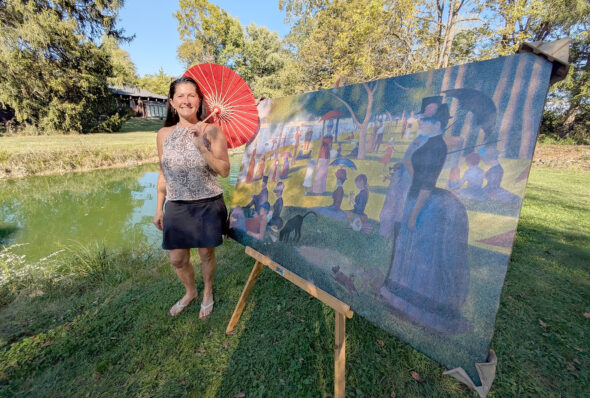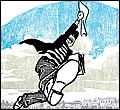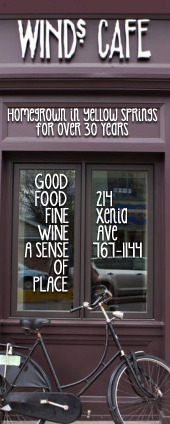
Local resident Valerie Kosheleff has spent the last few months planning to stage a tableau vivant of the Georges Seurat painting “A Sunday Afternoon on the Island of La Grande Jatte” — a goal that will come to fruition Sunday, Oct. 12, at Kosheleff’s Corry Street home. The event, in part, aims to honor the late Helen Birch Bartlett for whom Glen Helen was named; Bartlett was an art collector who purchased the Seurat piece and first brought it before U.S. eyes. (Photo by Lauren"Chuck" Shows)
Villagers to recreate Seurat painting
- Published: October 10, 2025
On a recent afternoon, local resident Valerie Kosheleff stood near a pond on her Corry Street property. Blue dye had been added to the water to make its hue closer to that of the pond in Georges Seurat’s “A Sunday Afternoon on the Island of La Grande Jatte” — the 1884 painting she plans to bring to life on Sunday, Oct. 12, as a tableau vivant, or living picture.
Around Kosheleff’s porch were piles of parasols, Victorian-style hats and dresses and an angular bustle, all set to play a part in restaging Seurat’s famous pointillist scene as both performance and community gathering. Villagers are invited to take part as actors, dancers, plein air painters or spectators, from 1–4 p.m., at 1333 Corry St. Admission is free, though registration is required at YSRecreatesLaGrandeJatte.eventbrite.com; donations will support the project’s costs.
Kosheleff said the event is a tribute not just to Seurat, but also to Helen Birch Bartlett — the late namesake of Glen Helen — who once owned Seurat’s “La Grande Jatte.” A century after her death, Bartlett is being reintroduced to the village as a key figure in American modern art collecting, as she and her husband, Frederic Clay Bartlett, acquired major works by Seurat, Matisse, Van Gogh and Picasso, which later formed the foundation of the Art Institute of Chicago’s modern collection.
“I knew about the painting, and studied it in France in 1994 … but I didn’t know that [Birch Bartlett] owned this masterpiece until this summer,” Kosheleff said.
It was a series of coincidences, Kosheleff said, that led her to the idea of re-creating “La Grande Jatte.” For several years, she’d known about Topiary Park in Columbus, designed to replicate the figures in Seurat’s painting using sculpted shrubs. She finally visited this spring.
Then, in June, she attended a screening of the remastered 1980 local documentary “First Came the Land” at the Little Art. During the event, local resident Bill Kent — who has been leading efforts to highlight Helen Birch Bartlett’s history this year, the 100th anniversary of her death — held up a print of “La Grande Jatte.”
“He said Helen owned it, and I thought, ‘I’m sure I didn’t hear him right,’” Kosheleff said.
Days later, a friend invited her to Chicago. With a few free hours, she stopped by the Art Institute, unaware that Seurat’s painting was part of a collection dedicated in Helen Birch Bartlett’s name. She was hoping to see works by Gustav Klimt, but there were none on display at that time.
“And thank goodness they weren’t there, because I don’t know that I would have seen [‘La Grande Jatte’] otherwise,” she said.
Those three coincidences became the creative spark for what will soon unfold in her yard. Having studied Carl Jung this year, Kosheleff connected the experience to his theory of synchronicity — that meaningful coincidences link inner thoughts with the outer world.
“Once you start living your true self, then you notice the synchronicities show up,” she said. “When I realized the importance of this project, it’s not because I have nothing else to do — it’s because this feels like living my true self.”
Kosheleff said that, though this will be the first large-scale art project she’s organized and produced, she has research and project management experience. A wildlife conservationist with a master’s degree in evolutionary biology, she studied at the Jane Goodall Institute and led research and advocacy in Zambia and California. She said she’s organized a number of events for her nonprofit, Save A Horny Friend Foundation, a campaign against rhinoceros poaching.
“I’ve never done an art event before, but so what?” she said. “I’m educated, and I love art, and I attend plenty of performances. The real driver is the fact that Helen was the last owner of these masterworks of art.”
So, Kosheleff began enlisting aid from every corner of the village she could get to in order to bring the project to life, she said. She secured a grant from the YS Community Foundation, and several residents have donated funds to the cause.
In the interim, Kosheleff has worked with or brought on board Aaron Willis to serve as DJ during the event; Issa Walker to film drone footage; Gyamfi Gyamerah on drums and recruiting other musicians for the live performance; Deb Henderson, Linda Cabaluna, Daisy Veitch and the Sister Trillium crew for costumes; Linda Cabaluna to make fliers and lend a monkey — as featured in “La Grande Jatte” — to the production; Jil Pauley to read Helen Birch Bartlett’s poetry; videographer and editor Rob Linder; Ali Thomas for audio editing advice; and Amy Wamsley to provide theatrical guidance. Also supporting the project are Bill Kent, who Kosheleff said has been “the champion and hero of this project,” and Eric Johnson, who offered to edit a short documentary about the project.
“My philosophy is that if you don’t ask, you don’t get — so I always ask,” she said. “I’m really grateful that some folks have said ‘yes.’”
The event itself, she said, will be hybridized — part performance, part photo shoot, part educational, part community gathering. Those planning to participate are asked to attend wearing colors represented by the figures painted in “La Grande Jatte”; some costumes will be provided, but Kosheleff stressed a desire for, if not period-accurate silhouettes, then vibrant, painting-accurate colors to be worn. She also asks folks to bring costumes for two other stagings of the painting, in which participants will be encouraged to dress both as the person they see themselves as, and also in what Kosheleff calls a “loudfit” — that is, a loud outfit.
“Whatever that means to you — outlandish ’60s or ’70s, Burning Man, Halloween,” she said.
The afternoon will unfold in musical sequences inspired by Seurat’s meticulous composition, set to a mash-up of three songs. First is Doris Day’s “Que Sera Sera” — both a tone-setter, Kosheleff said, and a nod to Seurat’s surname. Next comes Rihanna’s “Umbrella,” with colorful parasols from the painting pressed into service for a joyful dance. The mash-up concludes with Offenbach’s “Can-can,” taught and performed by the Dayton troupe Madame Gigi’s OUTRAGEOUS French Cancan Dancers, whom Kosheleff said were recommended by Brian Housh.
Kosheleff said that, for her, the project is significant as both a living art lesson and an homage to Helen Birch Bartlett’s legacy as a patron of modern art.
“I want to emphasize that this is an educational event. … It’s time to celebrate women,” she said. “It doesn’t matter whether it was Helen or her husband who chose the paintings — it was her money, and they all hang in her honor.”
Though the spectacle will last just a few hours, months of work have gone into planning it. Nevertheless, Kosheleff acknowledged that, with so many moving parts to an event that relies on community effort, her best-laid plans will undoubtedly shift on the day. Pointing to the English translation of the phrase “Que Sera Sera,” she said she’s willing to go with it.
“Because that’s how art works — you rarely control it,” she said. “Whatever will be, will be.”
One Response to “Villagers to recreate Seurat painting”
The Yellow Springs News encourages respectful discussion of this article.
You must login to post a comment.
Don't have a login? Register for a free YSNews.com account.















Hi,
I became a fan of Seurat when in high school in Paris, in the 60’s.
I also visited his conte’ crayon sketches at the Smith College art museum in Mass….just a few miles from my home in Amherst. Visited so often to the see a Cezanne, the Seurats and Rodin’s Walking Man – that the curator thought I was an Amherst college student writing a ‘paper’ of some sort. She had some Seurats returned, by cab!, from Harvard for me to study in her private office!
I was the right age for a college student…..nothing else.
Always wondered how Seurat’s Mona Lisa escaped France – to Chicago, of all places!
OK, to my question – please, how is Helen Birch Bartlett connected to Yellow Springs – other than her name on a park?
Thank you, Tom T.